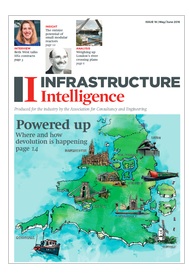Submitted by L. Millard on Tue, 28/06/2016 - 12:12
In the face of extreme events that could impact lifeline systems, Professor Tom O’Rourke says industry and academia must work together to innovate the next generation of hazard resilient underground infrastructure.

Pipelines are a ubiquitous and crucial part of our gas and liquid fuel, electric power, telecommunications, and water and wastewater infrastructure, providing lifelines to our modern communities. This infrastructure is a national treasure and, like much treasure, we bury it. But that presents challenges – we don’t see this complex mass of underground pipelines, often have incomplete maps to find them and can’t monitor their performance. Factor in uncertainty in the shape of extreme events – storms and floods, subsidence, earthquakes and terrorism – and the vulnerability of this out-of-sight infrastructure becomes evident. There is a pressing need for government and industry to identify, monitor and future-proof these assets to enable more resilient communities through improved systems performance.
But how do we encourage government and industry to adapt to and, crucially, adopt new technologies and techniques? Competition in the market can stimulate good practice. When the Los Angeles Department of Water and Power implemented a seismic resilience and sustainability program to safeguard the region’s water supply against a sizeable earthquake they turned to the Kubota Corporation in Japan. The company makes Earthquake Resistant Ductile Iron Pipe (ERDIP), designed to expand, compress and deflect underground deformation, with over 40 years of service during earthquakes in Japan. In 2011, these hazard-resistant pipes were imported and installed for a pilot project in five vulnerable locations in LA. Soon other water agencies in San Francisco, Portland and Seattle registered interest and demand stimulated innovation; U.S., Canadian, and other Japanese companies began to develop their own concepts and designs for hazard-resilient pipelines. Here you have innovation driven by an asset owner demanding a better solution and a wider market willing to follow.
The benefit of adopting new generation hazard resilient pipelines was evident in Christchurch, New Zealand, following the 2010-2011 Canterbury Earthquake Sequence. I was part of a team of researchers working on site in New Zealand during and after the earthquake sequence, witnessing first-hand the catastrophic consequences of fragile infrastructure. The city’s water pipelines, made mostly from cast iron, asbestos cement, and polyvinyl chloride, were significantly damaged from ground movement and liquefaction leaving most of the city without water. There were over 1,700 water main repairs caused by the 22 February 2011 earthquake alone, an exceptionally high total repair rate of nearly one repair per kilometre. In contrast, Christchurch’s modern gas distribution system, composed of thermally fused polyethylene piping, sustained virtually no damage in response to the combined effects of the earthquake sequence. What made the difference? The absence of damage related primarily to the ductility and durability of the pipelines in the gas distribution system – pipelines widely available but not widely adopted for water supply systems.
Understanding the effects of extreme events on infrastructure systems, and learning from them is key to building resilient communities. Research and innovation between academia and industry is generating new tools and strategies for improving infrastructure resilience through smart technologies and policies. At Cornell University, where I’m based, we are able to work alongside industry to test the next generation of pipelines at full scale in the lab under soil deformation that replicates earthquake-induced movements. These tests are used to validate analytical models and improve products before they are used in a real world environment. We collaborate with researchers at the Centre for Smart Infrastructure and Construction (CSIC), at the University of Cambridge, to develop 2D and 3D modelling using these test data for a better understanding of how various materials and structures behave under extreme conditions.
Instrumenting pipes using next generation sensing technology provides asset owners with important information about the condition of their underground infrastructure, which is critical for effective asset management during the product lifecycle, including extreme events.
The benefits of smart, resilient underground infrastructure are clear and overlooked at our peril:
- asset owners gain the information needed to make informed decisions about repairs
- shorter economic downturn after a major event, faster return to ‘business as usual’
- communities have the resources they need to combat secondary effects of hazards, i.e. water to combat fires after earthquakes
- fewer repairs mean less ongoing disruption.
The beneficiaries, owners, and managers of these assets must all plan for the future. Lifelines are about sustaining the life of our communities with the services and resources essential for health, security, and economic well-being.
Author
Professor O’Rourke is a key speaker at the International Conference on Smart Infrastructure and Construction (ICSIC) 2016, from 27 to 29 June 2016, at the University of Cambridge, organised and hosted by CSIC, which will bring together world-leading academics and practitioners from the fields of infrastructure planning, asset management and sensing. See http://www-icsic.eng.cam.ac.uk/.
Professor Tom O’Rourke is Chair of CSIC’s International Advisory Group and Thomas R Briggs Professor of Engineering in the School of Civil and Environmental Engineering at Cornell University. He is a member of the US National Academy of Engineering, International Fellow of the Royal Academy of Engineering, Distinguished Member of ASCE, and a Fellow of American Association for the Advancement of Science.
Professor O’Rourke has served on several teams reviewing and reporting on significant disasters, such as the attack against New York City on 11 September 2001, Hurricane Katrina and earthquakes around the world, as well as many large infrastructure projects.
This article was first published at Infrastructure Intelligence here and appeared in the magazine, May/June 2016 edition.
